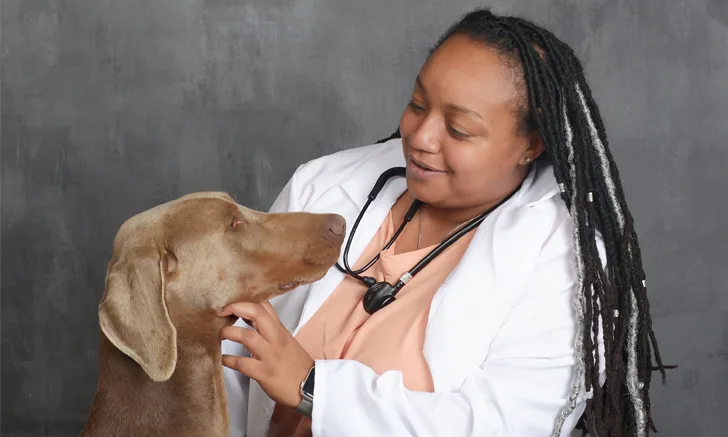
At 39, Dr. Cherice Roth wrote What Does a Real Doctor Look Like?, the book she wished she could have read when she was 8.
Kaylon, the young Black hero of What Does a Real Doctor Look Like? wants to be a doctor but doesn’t know if any doctors look like she does. When Kaylon asks her mother, “Do I look like a doctor?,” her mom says yes and introduces her cousin, who is a doctor. She tells Kaylon that doctors are of every race and ethnicity.
“Had this book been around when I was younger, I probably would have gone straight into veterinary medicine,” the now 40-year-old said. “Honestly, I just didn’t have an idea of what was possible.”
Finding Veterinary Medicine
Roth, who was born in Cleveland, Ohio, and grew up in Mesquite, Texas, was 8 when she met the neurosurgeon Ben Carson. “That was the spark for me to decide I want to be a doctor.”
She didn’t know about veterinary medicine when her childhood black Lab, Ebony, got sick. Despite the siblings feeding her chicken soup, Ebony died in their yard. Her family was poor and “didn’t have the resources to stop life in the middle of the week and take her and try to find a doctor,” Roth explained. “We were trying to get her to the weekend, I mean literally.”
Roth was the first in her family to go to college, and she learned about veterinary medicine in her junior year as a biology major. “That’s far later than most people,” she said. “Most veterinarians know by the time they are very young that they want to be a veterinarian, and they work toward that.”
She met more veterinarians as she did research as part of her master’s work in biochemistry at the University of North Texas Health Science Center. But it wasn’t until she was 3 years into her PhD work when her husband, Jeremy, suggested she look into becoming a veterinarian. “I think it was something that was supposed to happen,” said Roth, who now lives in Oregon.
Making Veterinary Care Accessible
After starting practice in Albuquerque, New Mexico, and working overnights in an emergency room, she saw families pooling their money for transportation to bring their pets to the clinic.
“The more exposure I got in veterinary medicine, the more it became super clear for animals in the US, far more are not getting care than the ones that are.”
The realization helped her see the importance of telemedicine for pets. Now, Roth is chief veterinary officer of Fuzzy Pet Health, an online veterinary service, as well as special programs coordinator of the Multicultural Veterinary Medical Association.
What’s a Real Doctor, Anyway?
What Does a Real Doctor Look Like? is the second in Roth’s “Real Doctor” series. It follows What’s a Real Doctor?, about the similarities between doctors who tend to people and doctors who take care of animals. A third book will be about different types of doctoral degrees.
Roth put What’s a Real Doctor? to paper after overhearing her 6- and 7-year-old sons tell friends about their mom’s work. In the story, the children discover that even though their classmate’s dad takes care of people and their mom cares for animals, the parents do the same things.
“All of us that are veterinarians at some point have been asked, ‘Why didn't you choose to become a real doctor?’ ” Roth said. “I want people to understand the beauty of being a veterinarian.”
What Do Veterinarians Look Like?
While What’s a Real Doctor? features a white protagonist and What Does a Real Doctor Look Like? focuses on a Black girl, Roth said she didn’t set out to write about diversity and inclusion. “It's my life, it is every day for me,” she said.
“I think that as a field we will get better when we have more doctors that look like all of us,” Roth explained. “Because that pulls in these families that lost pets in their backyard and didn't know about veterinary care.” These stories really help “expand our thinking around what veterinary care can look like for any animal.”